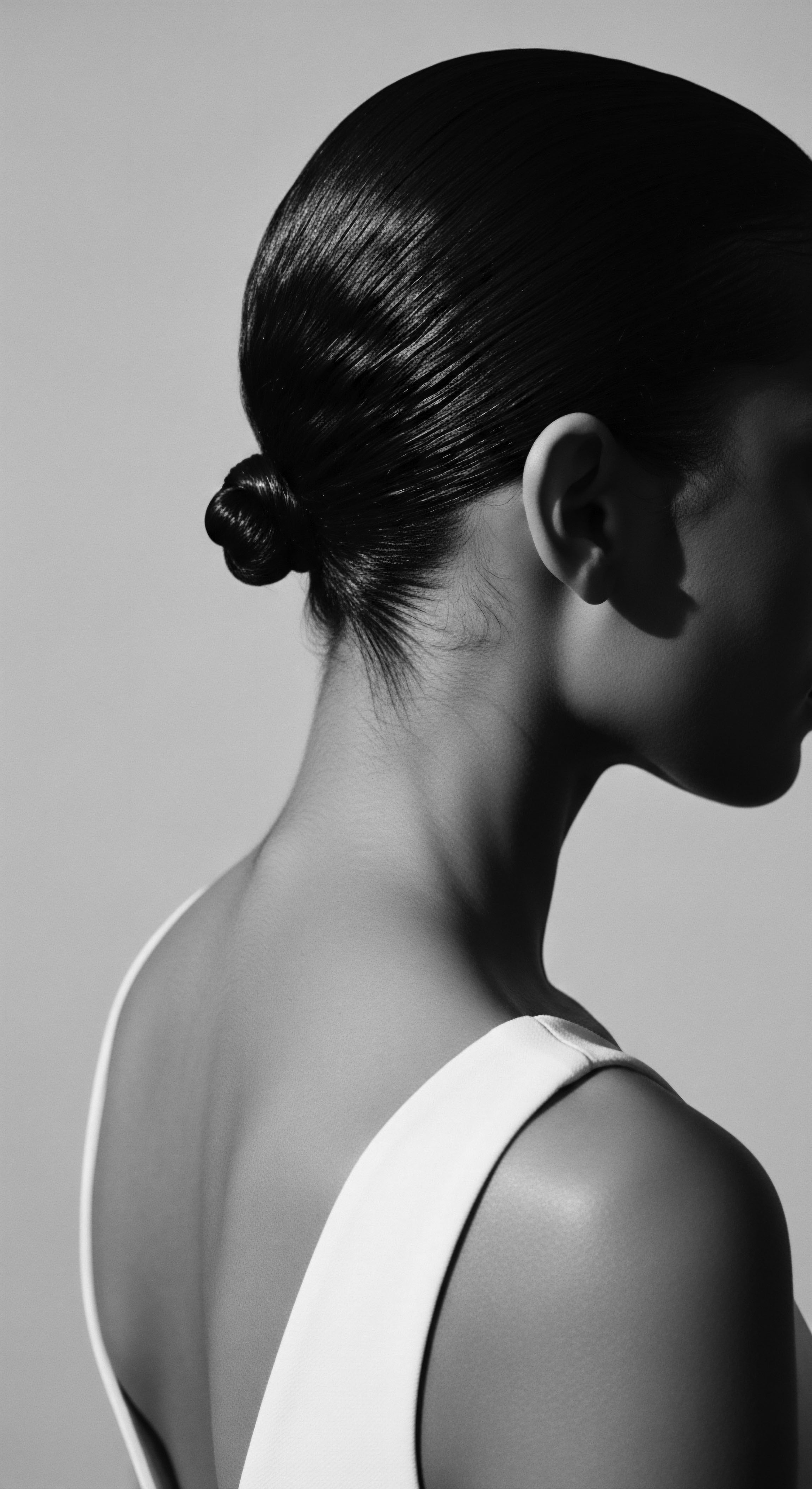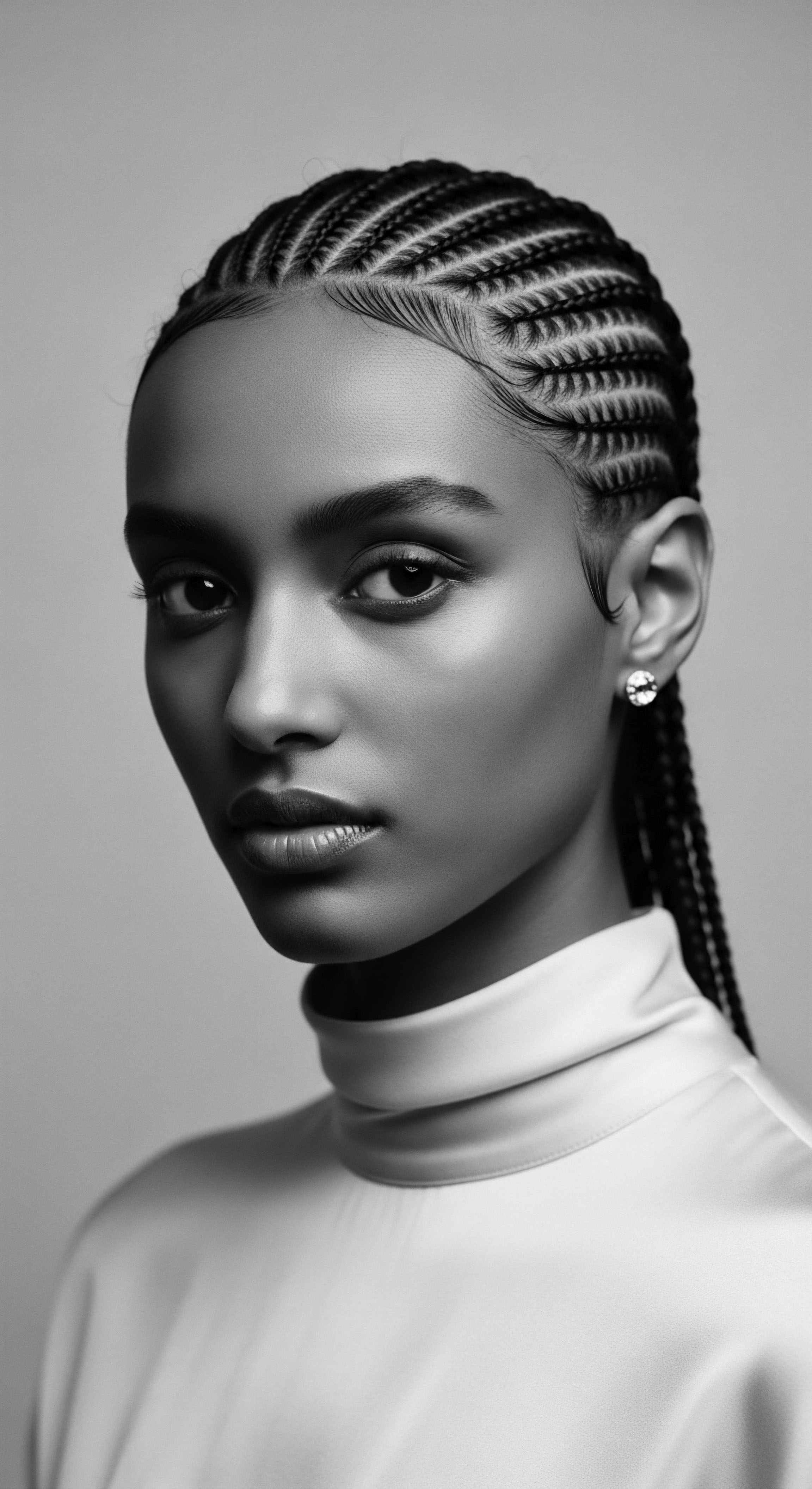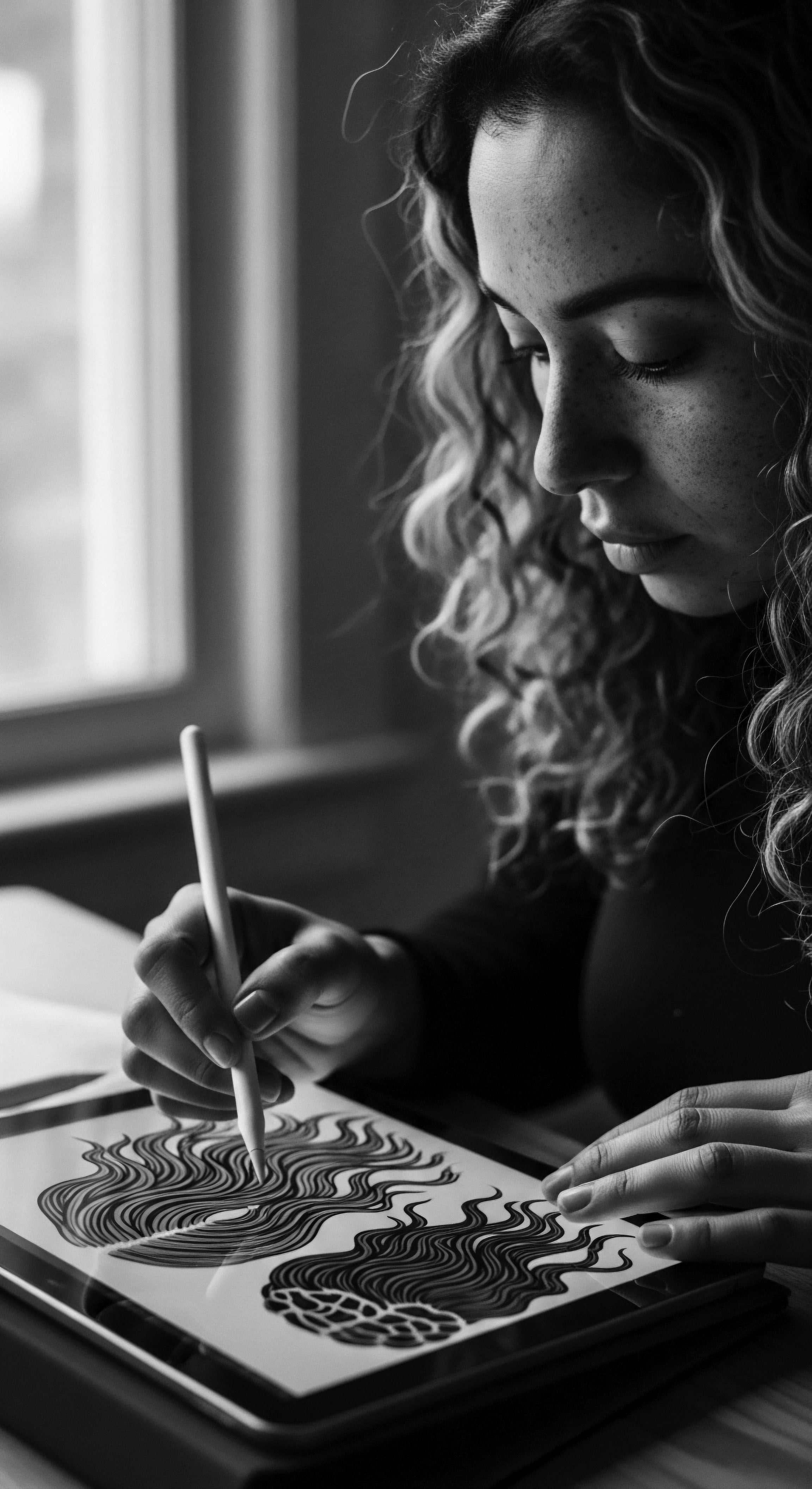
Roots
For countless generations, hair has been far more than a simple adornment; it has been a living archive, a sacred thread woven into the very fabric of identity for Black and mixed-race communities. It speaks of lineages, of journeys, and of the profound knowledge passed down through the ages. Before the advent of modern laboratories, our ancestors understood the profound particularities of textured hair, not through microscopes, but through generations of intimate observation and a deep relationship with the earth’s offerings.
They recognized its coil, its spring, its incredible ability to defy gravity, alongside its propensity for dryness and fragility. These were not flaws, but rather characteristics that demanded a unique, reverent approach to care.
In many ancient African societies, hair carried layers of meaning, serving as a silent language that conveyed status, age, marital standing, tribal affiliation, and even spiritual beliefs. Sieber and Herreman (2000) note that hairdressing was ancient in many sub-Saharan African societies, with artifacts preceding European contact demonstrating its early significance. This sophisticated understanding of hair’s role extended to its very nature, acknowledging that its distinct structure necessitated specific solutions for common concerns.
Dryness, a persistent challenge for coily hair due to its unique configuration that hinders natural sebum distribution, was met with rich emollient gifts from the land. Breakage, a vulnerability for hair prone to tangling and knotting, was addressed through gentle handling and protective styles.
Ancestral practices for textured hair were deeply embedded in the cultural understanding of hair as a profound marker of identity and spiritual connection.
The very anatomy of textured hair, with its elliptical shaft and characteristic twists, means cuticle layers often lift at various points along the fiber, leading to what modern science terms ‘high porosity.’ This configuration means that while textured hair can absorb water quickly, it can also lose moisture just as rapidly. Our forebears, through centuries of tactile experience, understood this natural inclination toward dehydration. They did not need complex scientific terms; they simply knew the hair required constant, thoughtful replenishment.

Understanding the Hair’s First Language
Before any product was considered, ancestral wisdom began with observation. They understood that the hair’s coiled structure, while beautiful, could also create points of vulnerability. This natural propensity for tangling meant that harsh manipulation was avoided, favoring methods that honored the curl pattern. The climate, too, dictated approaches; in hot, dry regions, the focus was squarely on retention of moisture, a practice that echoes the scientific need to seal the cuticle.
Consider the spiritual significance placed on hair by many African cultures. Among the Yoruba, for example, hair was regarded as the most elevated part of the body, a conduit for spiritual messages and a connection to the divine. This reverence ensured that hair care was never a mundane task, but a sacred ritual, performed with mindfulness and intention. This perspective fostered a gentle interaction with the hair, instinctively guarding against damage that might be incurred through rough handling.

Earth’s Larder for Hair’s Thirst
The solutions for maintaining hair’s vitality were drawn directly from the earth. Natural butters, oils, and herbs formed the cornerstone of ancestral hair care. These indigenous ingredients were chosen for their perceived ability to soothe the scalp, lubricate the strands, and maintain pliability.
- Shea Butter ❉ Derived from the nuts of the shea tree, native to West Africa, shea butter was a centuries-old staple, used for its rich emollient properties to moisturize hair and protect it from harsh environmental conditions. It provided a protective layer, helping to seal in moisture and reduce the feeling of dryness.
- Plant Oils ❉ Various plant oils were prized for their ability to nourish and condition. Ancient Egyptians, for instance, used oils from castor, sesame, and moringa plants for their hair and skin. West African traditions also widely utilized diverse oils and butters to keep hair moisturized.
- Herbal Infusions ❉ Local botanicals were often infused into water or oils to create tonics that addressed specific scalp conditions or promoted hair health. The Basara Tribe of Chad, for instance, used a mixture containing Chebe powder, an herb-infused blend, for length retention and overall hair health.

Ritual
The care of textured hair, in ancestral societies, was far removed from a solitary chore. It was a communal act, a tender thread weaving through the tapestry of family and community life. These rituals, passed from elder to youth, were moments of shared knowledge, of touch, and of quiet bonding that solidified familial ties and reinforced cultural identity. The solutions for common textured hair concerns were not found in isolated products, but within the rhythm of these collective practices.
The intimate act of washing, oiling, and braiding hair together created an unparalleled understanding of each strand’s needs. This hands-on, generational transmission of knowledge allowed for a truly individualized approach to hair care, long before modern regimens became segmented by ‘hair types.’ The patience inherent in these sessions, often lasting hours or even days, speaks volumes about the value placed on hair’s health and aesthetic expression.

The Communal Touch
Consider the act of braiding. In many African cultures, braiding was not merely a stylistic choice; it was a communal activity where mothers, daughters, and friends gathered, strengthening bonds while preserving cultural identity. This shared experience facilitated the transfer of intricate techniques for detangling, moisturizing, and styling. The very act of slow, methodical braiding served as a protective measure, minimizing manipulation and guarding the hair against daily wear that could lead to breakage.
The tools of ancestral hair care were extensions of their intimate understanding. While modern detangling brushes are lauded for their efficacy, ancient populations adapted what was available. During the era of enslavement, when access to traditional tools was severed, enslaved Africans ingeniously adapted sheep-fleece carding tools for detangling their matted hair, a testament to their enduring ingenuity and resilience in the face of immense hardship. This highlights a historical example of adapting to hair concerns under duress, a powerful illustration of the heritage of survival and care.

Balancing Moisture and Strength
Dryness, a perennial concern for coily hair, found its answer in consistent, layered moisture application. Ancestral practices understood the need to ‘seal in’ moisture, often through the application of natural oils and butters after washing or re-wetting the hair. This aligns with modern scientific understanding of emollients providing a barrier against moisture loss.
Hair care rituals, often communal and time-intensive, provided a holistic approach to hair health, addressing concerns through sustained nourishment and protective styling.
The historical practice of oiling, evident across various cultures, served multiple purposes. Beyond providing moisture, it added a protective layer, helping to shield the hair from environmental stressors and reducing friction that could cause breakage. Cleopatra, for instance, was said to have used castor oil as part of her beauty regimen, and olive oil was a staple in Greek hair care.
Methods for maintaining hair integrity between washes also emerged. Nighttime protection was essential, with neckrests or headrests used across Africa, including ancient Egypt and Nubia, to preserve elaborate coiffures during sleep. This foresight minimized friction and tangling, preventing breakage and maintaining style, a precursor to modern bonnets and silk pillowcases.
| Common Hair Concern Dryness |
| Ancestral Practice/Solution Regular application of natural butters (e.g. shea butter) and plant-based oils (e.g. castor oil, moringa oil). |
| Heritage Connection / Modern Insight These emollients provided deep, lasting moisture, a practice scientifically validated by their ability to seal the hair cuticle and prevent water loss. Traditional shea butter processing, often by women, links to community and economic stability. |
| Common Hair Concern Breakage / Fragility |
| Ancestral Practice/Solution Protective styling (e.g. braids, twists, bantu knots), gentle detangling methods, and minimizing manipulation. |
| Heritage Connection / Modern Insight These styles, with deep cultural roots across Africa, reduced exposure and friction, guarding delicate strands. Finger detangling and wide-tooth combs were implicitly understood to preserve hair integrity. |
| Common Hair Concern Tangles / Knots |
| Ancestral Practice/Solution Communal combing and pre-treatment with oils or water. Adaptation of tools like sheep-fleece carders during slavery. |
| Heritage Connection / Modern Insight The shared ritual of detangling fostered patience and care. The adaptation of everyday tools highlights resilience and resourcefulness in maintaining hair health despite immense adversity. |
| Common Hair Concern These traditional approaches illustrate a profound, intuitive understanding of textured hair's unique needs, passed down through generations. |

Relay
The ancestral practices for textured hair care are not relegated to dusty history books; they are living legacies, continually adapted, reinterpreted, and celebrated. The wisdom of our forebears, forged in observation and sustained by community, continues to inform contemporary approaches to hair health, even as it speaks to the enduring resilience of cultural identity through seismic historical shifts. The journey of textured hair through generations is a testament to this profound relay of knowledge.
The period of transatlantic slavery stands as a stark and tragic interruption in this lineage of care. One of the first acts of dehumanization inflicted upon enslaved Africans was the shaving of their heads. This act, as documented by Randle (2015), was intended to strip individuals of their African identity and sever cultural ties. Removed from their native lands, enslaved people lost access to the traditional tools, oils, and the communal time required for intricate hair care.
This resulted in hair becoming matted and damaged, often hidden under scarves. Yet, even in such brutal conditions, the spirit of hair care found ways to persist. Braiding, for instance, transformed into a clandestine means of communication, with patterns reportedly conveying routes to freedom or gathering points. This extraordinary adaptation underscores how deeply ingrained these practices were, transforming from symbols of status to tools of survival.

Preserving Knowledge Through Adversity
Despite deliberate attempts to erase cultural heritage, the core principles of ancestral hair care survived. The emphasis on moisture retention, the preference for low-manipulation styles, and the intuitive understanding of hair’s delicate structure were carried forward. This quiet yet profound resistance laid the groundwork for future generations to reclaim and rebuild their relationship with their hair.
The mid-20th century, particularly during the Civil Rights Movement, saw a powerful resurgence of natural hair as a symbol of Black pride and activism. The Afro, a style that embraced natural texture, became a bold statement against long-imposed Eurocentric beauty standards. This movement was not merely a stylistic trend; it was a profound cultural and political act, a re-embracing of ancestral roots that rejected forced assimilation.

How Did Ancestral Wisdom Inform Modern Hair Science?
Modern trichology and hair science often validate what ancestral practices understood intuitively. For example, the susceptibility of Afro-ethnic hair to dryness and breakage due to its unique spiral configuration and cuticle lifting is a recognized scientific fact. The ancestral solution of using occlusive agents like shea butter directly addresses this challenge by providing external lubrication and a barrier to moisture evaporation.
The practice of hair oiling, passed down through generations across South Asia, Africa, and beyond, is rooted in the belief that healthy hair begins at the scalp. Contemporary formulations may add complex botanicals, yet the fundamental principle of scalp nourishment and strand protection remains unchanged.
The journey of textured hair through history demonstrates an unbreakable chain of ancestral knowledge, adapting and persisting through eras of both cultural flourishing and profound adversity.
The continued prominence of protective styles—such as Braids, Twists, and Locs—in Black and mixed-race communities today directly reflects their ancestral roots. These styles minimize daily manipulation, reduce tangling, and allow hair to retain length, concerns that were instinctively addressed by ancient communities to manage fragility and dryness.
The shift towards what is now called the “natural hair movement” also highlights a conscious return to these heritage practices, prioritizing the hair’s inherent texture and health over chemically altered states that have historically been linked to damage and scalp disorders. This return to roots is a powerful affirmation of ancestral wisdom.

What Does the Enduring Heritage of Textured Hair Care Tell Us?
The story of textured hair care, from ancient African civilizations to the contemporary diaspora, is a powerful illustration of cultural continuity and adaptation. It reveals that solutions for common hair concerns were not, and are not, solely about superficial aesthetics. They are deeply intertwined with identity, community, and the profound resilience of a people.
The continuity of care routines, whether through direct transmission or adaptive re-creation, speaks to an intrinsic value placed on healthy hair. This heritage also offers a template for holistic well-being, where hair care is a moment of self-connection, a nod to those who came before, and an act of cultural affirmation. The collective journey of textured hair is an ongoing testament to human ingenuity and the enduring power of ancestral wisdom.

Reflection
As we gaze upon a single strand of textured hair, we perceive more than mere protein and pigment. We observe a legacy, a delicate yet powerful filament spun through centuries of human experience, cultural significance, and ancestral wisdom. The journey through the echoes of ancient practices and the tender threads of living traditions reveals that solutions for textured hair concerns were never isolated remedies. Instead, they were deeply entwined with communal life, spiritual understanding, and a profound respect for the gifts of the earth.
From the strategic application of shea butter to temper dryness, to the intricate braiding patterns that safeguarded fragile strands and fostered community bonds, our ancestors crafted a continuum of care. This heritage, marked by both thriving traditions and painful disruptions, speaks to an unwavering commitment to self-preservation and identity. The resilience of textured hair, so often subjected to external pressures, mirrors the resilience of the cultures that nurture it.
Roothea’s ‘Soul of a Strand’ ethos finds its true resonance in this living library of textured hair heritage. It is a call to recognize that the deepest wisdom for our coils and curls lies not only in scientific formulations but in the quiet, insistent hum of generational knowledge. To care for textured hair is to honor a lineage, to partake in a ritual that connects us to a past of ingenuity and a future of boundless self-expression. It is a journey of discovery, where every gentle touch, every nourishing ingredient, and every protective style becomes a conversation with our ancestors, a reaffirmation of beauty, and a powerful declaration of who we are.

References
- Wong, N. Williams, K. Tolliver, S. & Potts, G. (2025). Historical Perspectives on Hair Care and Common Styling Practices in Black Women. Journal of Drugs in Dermatology, 24(3).
- Diedrich, K. & Herreman, F. (2000). Hair in African Art and Culture. Museum for African Art.
- Bero, T. (2021). Tangled Roots ❉ Decoding the History of Black Hair. CBC Radio .
- Cripps-Jackson, S. (2020). The History of Textured Hair. Colleen .
- Randle, M. (2015). An Analysis of African American Hair in the American Context. Clemson University.
- Tharps, L. (2001). Hair Story ❉ Untangling the Roots of Black Hair in America. St. Martin’s Press.
- Forbes, A. (2025). The Untold Story of Jojoba Oil in Black Beauty. BeautyMatter .
- Bess, K. (2022). It’s More Than ‘Just’ Hair ❉ Revitalization of Black Identity. Folklife Magazine .
- Okosun, K. Omorogieva, I. Okosun, C. (2024). Cosmetopoeia of African Plants in Hair Treatment and Care ❉ Topical Nutrition and the Antidiabetic Connection? MDPI .
- Danjuma, M. & Sani, L. (2024). Ethnobotany of traditional plant cosmetics utilized by women; A study in Northern Ghana. ResearchGate .
- Wilson, E. (2022). Everything You Need To Know About The Ancient Art Of Hair Oiling. Newsweek .
- Gordon, M. (2018). A Visual History of Iconic Black Hairstyles. BET.
- Ashe, B. (2008). Twisted ❉ My Dreadlock Chronicles. Agate Publishing.
- Chambers, S. (2025). Ancestral Hair Rituals to Nourish Your Hair and Soul. Substack .
- Taylor, J. (2018). Hair Raising Facts About Ancient Egyptian Hairstyles. Humerus Revelations of the Naked Ape .
